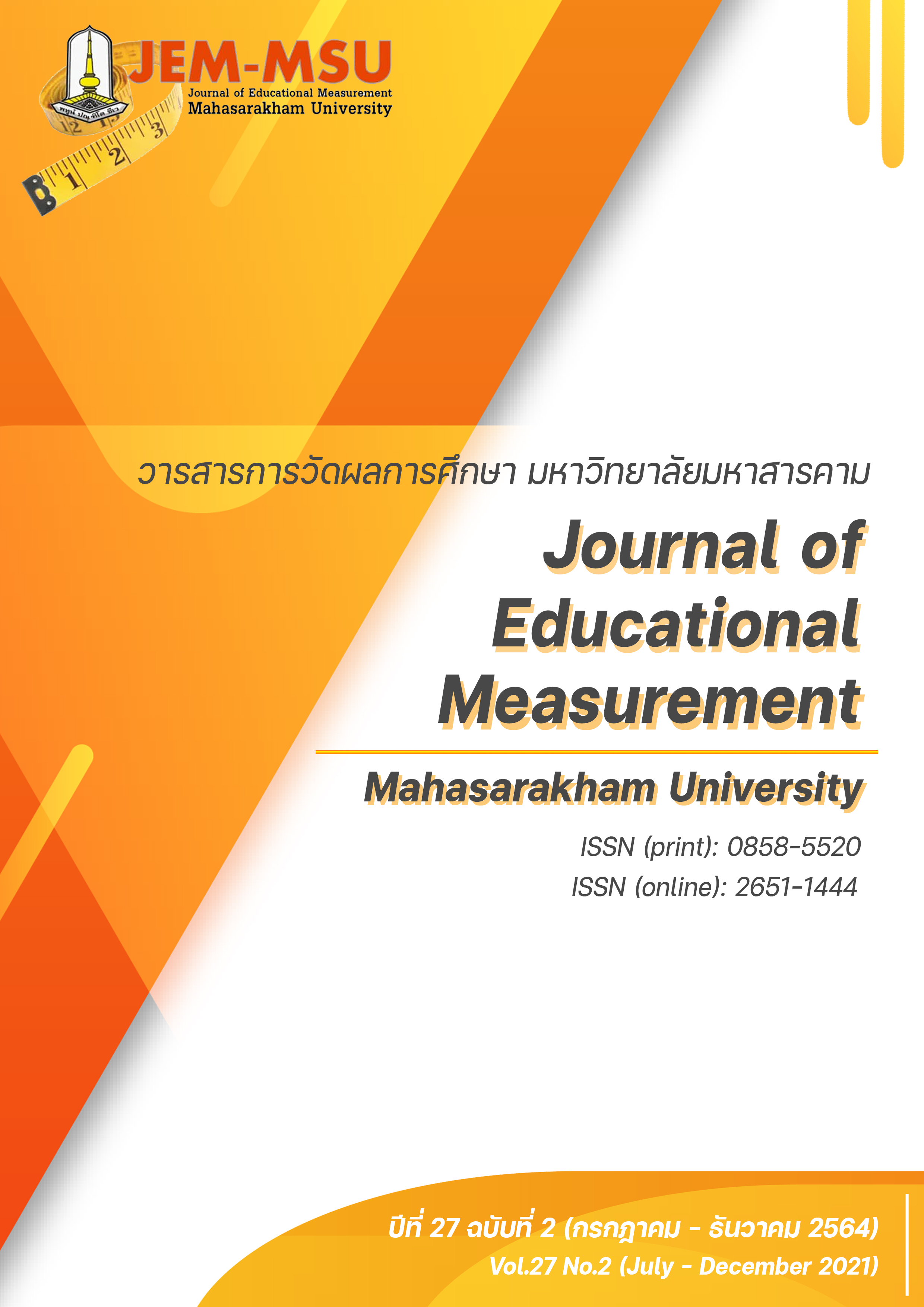Evaluation of Vocational Skill Practicum Project for Third-Year Vocational Certificate Students by Applying Collaborative Evaluation: A Case Study of Chumsaengchanutid School
Main Article Content
Abstract
This research aimed to evaluate the vocational skill practicum project for third-year vocational certificate students of Chumsaengchanutid School, by applying collaborative evaluation. In this evaluation, the stakeholders participated in the evaluation process from the beginning to the conclusion of the project. The applied evaluation process consisted of 3 steps: 1) clarifying the project evaluation details, 2) designing the evaluation, and 3) implementing the project evaluation. The data sources were stakeholders of the project. They were the project owner, teachers in the commerce learning strand, mentors in the establishment, students, customers, and parents. The tools used in the evaluation were interviews, questionnaires, focus group issues, evaluation forms, and a test. The qualitative data analysis employed content analysis and the results were presented through a summary. The statistics used in data analysis were percentage, the mean, and standard deviation. The issues to be evaluated were grouped according to the objectives, based on the system approach concept. The results are summarized as follows:
1) Regarding readiness of the input, it was found that the personnel and budget were ready and adequate for the operation. Regarding the media, materials, equipment and facilities, they were adequate. However, student name tags were not durable. The training documents were not in a complete set as required by the users. The evaluation team, therefore, prepared additional documents to complete the set and cover the roles and duties of the users. The documents were based on the roles and responsibilities of the users: the supervising teachers, students and the mentors of the establishment.
2) For the process evaluation, it was found that: (1) The selection of the establishment was complete as planned and students arrangement for the practicum was appropriate according to the criteria; (2) Regarding the orientation, the venue and content of the lecture were appropriate. However, student demonstrations which were in large groups should be organized in small groups so everyone could see them clearly. (3) In supervision, the supervising teachers followed the procedure specified. Coordination with the mentors had no problems; there was cooperation in reporting students’ behavior. In following up on the work of the mentors, problems with work assignment were found, due to unclear communication, and (4) In the post-training supervisory session and exchange of experiences, it was found that the venue, sequences of activities, and student participation were appropriate. However, the students wanted to increase their knowledge sharing activities to learn about solving various problems in the practicum.
3) On the output, the findings revealed the following: (1) every student had knowledge and practical experience, based on the guidelines, that passed 60% criterion, (2) the students had acquired good work skills, (3) the students had virtues and ethics at a good level, (4) the students had a good attitude toward honest careers at the highest level, and (5) every student participated in the post-training supervisory session activities and experience sharing.
4) Concerning the outcome, it was found that most students were still interested in continuing their study or work in their field or in a related career path. The practicum did not require or guarantee that the establishment would give the student a job, as some students were not sufficiently qualified, and the training period was too short.
5) Regarding the impacts, the evaluation results were as follows: (1) the positive impacts were: the establishment had a better image due to fast working and the students had more experience to be ready to work in a real career in the future, and (2) the negative impact: some parents were concerned about the safety of their children on their trip.
Article Details
The content and information contained in the published article in the Journal of Educational Measurement Mahasarakham University represent the opinions and responsibilities of the authors directly. The editorial board of the journal is not necessarily in agreement with or responsible for any of the content.
The articles, data, content, images, etc. that have been published in the Journal of Educational Measurement Mahasarakham University are copyrighted by the journal. If any individual or organization wishes to reproduce or perform any actions involving the entirety or any part of the content, they must obtain written permission from the Journal of Educational Measurement Mahasarakham University.
References
ทิพย์ฆัมพร เกษโกมล. (2545). การวิจัยและพัฒนาระบบการประเมินการเรียนรู้ของนักศึกษาพยาบาลตามแนวคิดการประเมินแบบร่วมมือรวมพลัง. ได้จาก http://cuir.car.chula.ac.th/handle/123456789/10546. [สืบค้นเมื่อวันที่ 28 กันยายน 2562].
ประชุม รอดประเสริฐ. (2547). การบริหารโครงการ. (พิมพ์ครั้งที่ 7). กรุงเทพฯ : เนติกุลการพิมพ์.
ประสาน จันทร์ดาสุด. (2561). การศึกษาคุณลักษณะที่พึงประสงค์ของผู้เรียนระดับประกาศนียบัตรวิชาชีพในจังหวักระยอง จันทบุรี และตราด. วิทยานิพนธ์ ค.ม. สาขาการบริหารการศึกษา มหาวิทยาลัยราชภัฎรำไพพรรณี, จันทบุรี.
รักชนก โสภาพิศ. (2553). การพัฒนารูปแบบการเตรียมความพร้อมการฝึกประสบการณ์วิชาชีพสำหรับนักศึกษาสาขาวิชาการจัดการการท่องเที่ยว. ปริญญาปรัชญาดุษฎีบัณฑิต สาขาหลักสูตรและวิธีการสอนบัณฑิตวิทยาลัย มหาวิทยาลัยศิลปากร.
ราตรี นันทสุคนธ์. (2547). การพัฒนารูปแบบการประเมินแบบร่วมมือสำหรับประเมินการฝึกประสบการณ์วิชาชีพครูของสถาบันราชภัฎ. วิทยานิพนธ์ กศ.ด. สาขาวิจัยและประเมินผลการศึกษา มหาวิทยาลัยนเรศวร, พิษณุโลก.
สำนักงานคณะกรรมการการอาชีวศึกษา. (2556). หลักสูตรประกาศนียบัตรวิชาชีพ พุทธศักราช 2556. ได้จาก http://bsq2.vec.go.th/course/2556/2-05-56/7% 20พาณิชยกรรม.pdf [สืบค้นเมื่อวันที่ 9 พฤษภาคม 2562].
สำนักมาตรฐานการอาชีวศึกษาและวิชาชีพ. (2551). แนวปฏิบัติการดำเนินการฝึกงาน. ได้จาก http://bsq.vec.go.th/document/ฝึกงาน%20_Dec.08_.pdf. [สืบค้นเมื่อวันที่ 9 พฤษภาคม 2562].
อมรศักดิ์ สินเหลือ. (2558). การพัฒนาโครงการพัฒนาศักยภาพหมู่บ้านขนาดเล็ก กลาง ใหญ่ เพื่อประโยชน์สูงสุดของประชาชน ในจังหวัดมหาสารคาม. วิทยานิพน์ปรัชญาดุษฎีบัณฑิต สาขาวิชารัฐประศาสนศาสตร์ วิทยาลัยบัณฑิตศึกษาด้านการจัดการ มหาวิทยาลัยศรีปทุม.
Muhsin, M.O., David L.W., & Jeffrey J.M. (2012). Collaborative evaluation of a high school prevention curriculum: How methods of collaborative evaluation enhanced a randomized control trial to inform program improvement. Evaluation and program planning, 35(4), 529-534.
O'Sullivan, R.G. (2004). Practicing Evaluation: A Collaborative Approach. Thousand Oaks, CA: Sage Publications.


